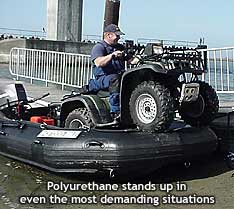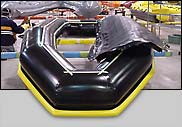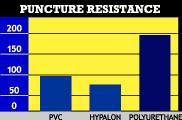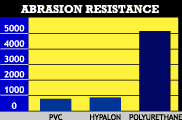

Polyurethane is the strongest air-holding material available.
 The
fabric consists of three layers. Two layers of extruded elastomeric
100% Urethane film are sandwiched around and chemically-mechanically
bonded to a center layer of high tenacity, tightly woven 14 oz
per yard nylon base fabric. The PU film is distributed 60/40.
The outer layer has 60% of the Urethane and the inner layer has
40%. Therefore, the outer layer weighs about 16 oz per yard and
the inner about 10 oz per yard. Together with the base fabric
the total weight of the fabric is a minimum of 40oz/yard.
The
fabric consists of three layers. Two layers of extruded elastomeric
100% Urethane film are sandwiched around and chemically-mechanically
bonded to a center layer of high tenacity, tightly woven 14 oz
per yard nylon base fabric. The PU film is distributed 60/40.
The outer layer has 60% of the Urethane and the inner layer has
40%. Therefore, the outer layer weighs about 16 oz per yard and
the inner about 10 oz per yard. Together with the base fabric
the total weight of the fabric is a minimum of 40oz/yard.
40oz nylon based, 100% PolyUrethane material offers four times the abrasion resistance and greater tear or tensile strength compared to Hypalon® /neoprene layered fabric of comparable weight.
Polyurethane fabrics have excellent welding properties. Wing uses both hot air/pressure rotary Welders and Radio Frequency Welders to join the material together in a molten state, thereby creating an incredibly strong bond. We do not have seam failures.
The combination of the elastomeric properties of Urethane and the resiliency properties of nylon allow the material to repeatedly stretch and still recover to show its original properties.
Polyurethane was originally manufactured in the early 70's as fuel cell bladders for helicopter fuel for military use. In the 80's it was used as an inflatable boat fabric. In the 90’s, the third generation of Coolthane® emerged from the Cooley labs. It has proved to be the ideal material for sponsons.
In
1993 the Navel Surface Warfare Center did a study on
polyurethane and the advantages of using it for Rigid
Inflatable boats. What they learned is: |
|
1. The process of heat welding vs. gluing seams has lead to a process promising an incredibly strong, permanent seam. Wing Inflatables takes that one step further in taping each seam with PU tape for superior air-holding, extraordinary strength and longevity. 2. Polyurethane is easy to repair. Damaged fabric can be easily repaired using adhesive and a heat gun. The cure time on polyurethane adhesives is 5 hours vs. 1-2 days for Hypalon® adhesives. 3. Polyurethane takes 200 pounds of pressure with a modified screwdriver to puncture the fabric. 4. Polyurethane fabric is highly resistant to most solvents, fuels and chemicals. 5. The elimination of solvents in the joining process of urethane coated fabrics avoids health and environmental concerns. 6. Polyurethane is not PVC. The only similarity is that both fabrics can be heat welded. PVC is an unstable polymer because of the chemical make up of the fabrics coating. This means that the PVC fabric is constantly changing, oxidizing and migrating to the surface. PVC's are liquefied with solvents where polyurethane is liquefied by heat, leading to a significantly more stable fabric coating. Stories about tubes rotting in the sun are about PVC - not polyurethane. 7. Wing Inflatables rigorously tests each lot of fabric for scrim adhesion, the bond between the urethane films and the nylon base fabric, coating thickness, and weldability before using any of it in our production.
|

ADVANTAGES
OF POLYURETHANE FABRIC |
|


